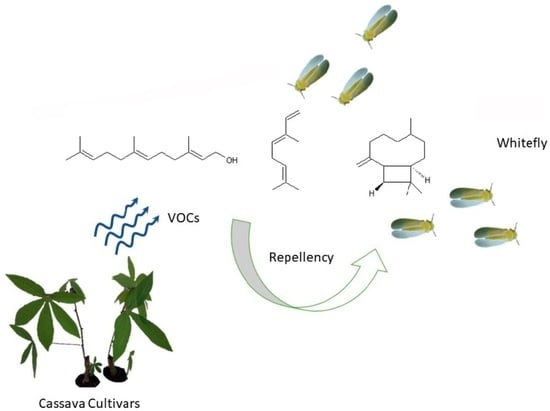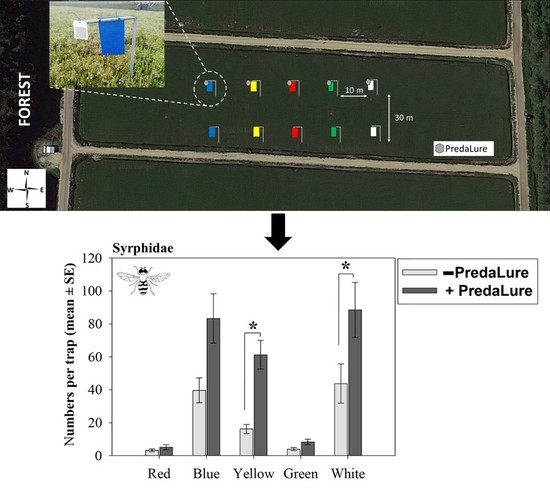Advancing the Use of Plant Volatile in Biological Control of Insects and Weeds
(Closed)
Share This Topical Collection
Editors
 Prof. Dr. Michael Rostás
Prof. Dr. Michael Rostás
 Prof. Dr. Michael Rostás
Prof. Dr. Michael Rostás
E-Mail
Website
Collection Editor
Agricultural Entomology, Department of Crop Sciences, University of Göttingen, 37073 Göttingen, Germany
Interests: applied and fundamental entomology; chemical ecology; biological control; IPM; biogenic volatiles; plant-insect-microbe interactions; plant resistance
 Prof. Stefano Colazza
Prof. Stefano Colazza
 Prof. Stefano Colazza
Prof. Stefano Colazza
E-Mail
Website
Collection Editor
Dipartimento di Scienze Agrarie, Alimentari e Forestali, Universitá degli Studi di Palermo, 90133 Palermo, Italy
Interests: general and applied entomology; biological control; chemical ecology; multitrophic interactions; herbivore-induced plant volatiles
Topical Collection Information
Dear Colleagues,
Plants emit a plethora of volatile organic compounds, either constitutively or because of biotic interactions with microorganisms and herbivores. Such volatiles serve as host recognition cues (kairomones) for herbivores or host habitat cues (synomones) for their natural enemies. Volatiles hold great potential for sustainable pest and weed management; however, there is a large gap between fundamental knowledge and the application of plant volatiles. This Topical Collection highlights new research with a focus on how plant volatiles could be applied in classical, augmentative, and conservation biological control.
Prof. Dr. Michael Rostás
Prof. Stefano Colazza
Collection Editors
Manuscript Submission Information
Manuscripts should be submitted online at www.mdpi.com by registering and logging in to this website. Once you are registered, click here to go to the submission form. Manuscripts can be submitted until the deadline. All submissions that pass pre-check are peer-reviewed. Accepted papers will be published continuously in the journal (as soon as accepted) and will be listed together on the collection website. Research articles, review articles as well as short communications are invited. For planned papers, a title and short abstract (about 100 words) can be sent to the Editorial Office for announcement on this website.
Submitted manuscripts should not have been published previously, nor be under consideration for publication elsewhere (except conference proceedings papers). All manuscripts are thoroughly refereed through a single-blind peer-review process. A guide for authors and other relevant information for submission of manuscripts is available on the Instructions for Authors page. Insects is an international peer-reviewed open access monthly journal published by MDPI.
Please visit the Instructions for Authors page before submitting a manuscript.
The Article Processing Charge (APC) for publication in this open access journal is 2600 CHF (Swiss Francs).
Submitted papers should be well formatted and use good English. Authors may use MDPI's
English editing service prior to publication or during author revisions.
Keywords
- sustainable agriculture
- biological control
- natural enemies
- volatile organic compounds
- pest management
Published Papers (4 papers)
Open AccessArticle
Perceptual Effects of Walnut Volatiles on the Codling Moth
by
Peixuan Li, Yang Wei, Guoxiang Chen and Adil Sattar
Viewed by 762
Abstract
The volatile organic compounds (VOCs) of plant hosts allow insect localization through olfactory recognition. In this study, the oviposition behavior of the codling moth was investigated and the VOCs from different walnut organs were extracted and analyzed to systematically study their composition and
[...] Read more.
The volatile organic compounds (VOCs) of plant hosts allow insect localization through olfactory recognition. In this study, the oviposition behavior of the codling moth was investigated and the VOCs from different walnut organs were extracted and analyzed to systematically study their composition and content differences. The electrophysiological and behavioral responses of the codling moth to walnut VOCs were measured using gas chromatography–electroantennographic detection (GC-EAD) and a four-arm olfactometer to screen the key active contents. The field investigation results indicated that 90.3% of the eggs spawned by the first generation of adult codling moths were adjacent to the walnut fruits. Walnut VOCs are mainly composed of terpenes, aromatics, and alkanes. Twelve VOCs can produce electroantennogenic (EAG) responses in the codling moths. Both adult males and females exhibit concentration dependence, with notable disparities in their EAG response levels. In the olfactory behavioral bioassay, linalool, eucalyptol, and high doses of geranyl acetate showed repellent effects on the codling moths, while myrcene, β-ocimene, nonanal, methyl salicylate, α-farnesene, and heptaldehyde showed the opposite. The relative levels of heptaldehyde, geranyl acetate, nonanal, and methyl salicylate were high in the fruits, which is intimately related to the localization of the walnut fruit by females. These VOCs can influence the oviposition behavior of codling moths but their application in the control of this pest needs to be confirmed and improved through further field experiments.
Full article
►▼
Show Figures
Open AccessEditor’s ChoiceArticle
Volatile Organic Compounds from Cassava Plants Confer Resistance to the Whitefly Aleurothrixus aepim (Goeldi, 1886)
by
Thyago Fernando Lisboa Ribeiro, Demetrios José de Albuquerque Oliveira, João Gomes da Costa, Miguel Angel Martinez Gutierrez, Eder Jorge de Oliveira, Karlos Antonio Lisboa Ribeiro Junior, Henrique Fonseca Goulart, Alessandro Riffel and Antonio Euzebio Goulart Santana
Viewed by 1470
Abstract
Cassava is an essential tuber crop used to produce food, feed, and beverages. Whitefly pests, including
Aleurothrixus aepim (Goeldi, 1886) (Hemiptera: Aleyrodidae), significantly affect cassava-based agroecosystems. Plant odours have been described as potential pest management tools, and the cassava clone M Ecuador 72
[...] Read more.
Cassava is an essential tuber crop used to produce food, feed, and beverages. Whitefly pests, including
Aleurothrixus aepim (Goeldi, 1886) (Hemiptera: Aleyrodidae), significantly affect cassava-based agroecosystems. Plant odours have been described as potential pest management tools, and the cassava clone M Ecuador 72 has been used by breeders as an essential source of resistance. In this study, we analysed and compared the volatile compounds released by this resistant clone and a susceptible genotype, BRS Jari. Constitutive odours were collected from young plants and analysed using gas chromatography–mass spectrometry combined with chemometric tools. The resistant genotype released numerous compounds with previously described biological activity and substantial amounts of the monoterpene (
E)-β-ocimene. Whiteflies showed non-preferential behaviour when exposed to volatiles from the resistant genotype but not the susceptible genotype. Furthermore, pure ocimene caused non-preferential behaviour in whiteflies, indicating a role for this compound in repellence. This report provides an example of the intraspecific variation in odour emissions from cassava plants alongside information on odorants that repel whiteflies; these data can be used to devise whitefly management strategies. A better understanding of the genetic variability in cassava odour constituents and emissions under field conditions may accelerate the development of more resistant cassava varieties.
Full article
►▼
Show Figures
Open AccessArticle
Microencapsulation of Capsaicin in Chitosan Microcapsules: Characterization, Release Behavior, and Pesticidal Properties against Tribolium castaneum (Herbst)
by
Su-Fen Cui, Jin-Wei Wang, Hai-Feng Li, Ran Fang, Xin Yu and Yu-Jie Lu
Cited by 11 | Viewed by 3407
Abstract
Capsaicin is a capsaicinoid in hot chili peppers, with excellent antibacterial and antimicrobial activities and a good safety profile, but its poor solubility and instability restrict its effectiveness. This limitation may be mitigated by encapsulation. Herein, capsaicin microcapsules (CCMs) were prepared through layer-by-layer
[...] Read more.
Capsaicin is a capsaicinoid in hot chili peppers, with excellent antibacterial and antimicrobial activities and a good safety profile, but its poor solubility and instability restrict its effectiveness. This limitation may be mitigated by encapsulation. Herein, capsaicin microcapsules (CCMs) were prepared through layer-by-layer self-assembly, using chitosan and carboxymethyl chitosan as shell materials. The chemical and microstructure structural characterization was evaluated by the methods of Fourier transform infrared spectroscopy (FTIR), scanning electron microscopy (SEM), and X-ray diffraction (XRD). The SEM indicated the microcapsules were irregular in shape with an average size of about 100 μm. The encapsulation had a high loading efficiency of 64.31%. FTIR and XRD revealed the absence of the interaction between the core and shell materials and the amorphous nature of the CCMs. The analysis results of the microcapsules’ release behavior showed the burst release of capsaicin in 7 days and a slow progression afterward in three solutions, with the highest release properties in a basic solution, followed by acidic and neutral salt solutions. The entomotoxicity of CCMs was conducted against
Tribolium castaneum (Herbst), and its efficacy was compared with pure capsaicin. The CCMs were found to be highly effective against this pest. The LC
50 value for capsaicin and its microcapsules was 31.37 and 29.75 mg/kg on adults, respectively. According to these values,
T. castaneum’s development and reproduction were significantly inhibited compared with the control group. The excellent physicochemical characteristics and insecticidal performance show a high application value for integrated pest control.
Full article
►▼
Show Figures
Open AccessCommunication
Interactive Effects of an Herbivore-Induced Plant Volatile and Color on an Insect Community in Cranberry
by
Cesar Rodriguez-Saona, Pablo Urbaneja-Bernat, Jordano Salamanca and Vanessa Garzón-Tovar
Cited by 5 | Viewed by 4187
Abstract
Synthetic herbivore-induced plant volatiles (HIPVs) could be used to monitor insect populations in agroecosystems, including beneficial insects such as natural enemies of herbivores. However, it is unknown whether insect responses to HIPVs are influenced by visual cues, e.g., color. We hypothesized that the
[...] Read more.
Synthetic herbivore-induced plant volatiles (HIPVs) could be used to monitor insect populations in agroecosystems, including beneficial insects such as natural enemies of herbivores. However, it is unknown whether insect responses to HIPVs are influenced by visual cues, e.g., color. We hypothesized that the HIPV methyl salicylate (MeSA) interacts with color to affect insect captures on sticky traps. To test this, we conducted a 5 × 2 factorial field experiment in a commercial cranberry farm to monitor numbers of insect predators, parasitoids, and herbivores by using five colored sticky traps that were either baited with a MeSA lure (named ‘PredaLure’) or unbaited. At the community level, PredaLure increased captures of predators. At the individual-taxon level, captures of the hoverfly
Toxomerus marginatus (Diptera: Syrphidae) and thrips (Thysanoptera: Thripidae) were higher on PredaLure-baited traps. However, only captures of
T. marginatus on PredaLure-baited traps interacted significantly with color such that the numbers of this hoverfly on yellow and white traps were 2–4 times higher when baited with PredaLure. This study is the first to document the interactive effects of synthetic HIPVs and color on an insect community. Our findings have implications for optimal selection of HIPV-baited colored traps to monitor natural enemy populations in agroecosystems.
Full article
►▼
Show Figures











